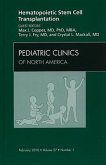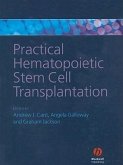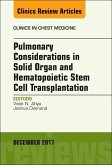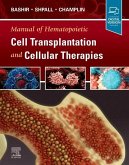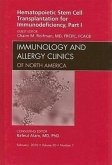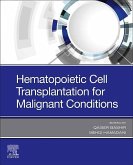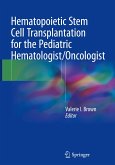Schade – dieser Artikel ist leider ausverkauft. Sobald wir wissen, ob und wann der Artikel wieder verfügbar ist, informieren wir Sie an dieser Stelle.
- Gebundenes Buch
- Merkliste
- Auf die Merkliste
- Bewerten Bewerten
- Teilen
- Produkt teilen
- Produkterinnerung
- Produkterinnerung
A guide to the practice of stem cell transplantation, its status in the treatment of various disorders and the problems that arise after transplantation, aimed at the whole transplant team. * An up to date guide to best practice in the use of stem cell transplantation, covering current status in the treatment of malignant and non-malignant conditions, practical aspects and problems such as infection and graft versus host disease. * Has a practical, accessible approach with free use of algorithms, list tables. * Aimed at the whole transplant team - this is an interdisciplinary field. *…mehr
Andere Kunden interessierten sich auch für
![Hematopoietic Stem Cell Transplantation, an Issue of Pediatric Clinics Hematopoietic Stem Cell Transplantation, an Issue of Pediatric Clinics]() Max J. CoppesHematopoietic Stem Cell Transplantation, an Issue of Pediatric Clinics52,99 €
Max J. CoppesHematopoietic Stem Cell Transplantation, an Issue of Pediatric Clinics52,99 €![Practical Hematopoietic Stem Cell Transplantation Practical Hematopoietic Stem Cell Transplantation]() Andrew Cant / Angela Galloway / Graham Jackson (eds.)Practical Hematopoietic Stem Cell Transplantation177,99 €
Andrew Cant / Angela Galloway / Graham Jackson (eds.)Practical Hematopoietic Stem Cell Transplantation177,99 €![Pulmonary Considerations in Solid Organ and Hematopoietic Stem Cell Transplantation, an Issue of Clinics in Chest Medicine Pulmonary Considerations in Solid Organ and Hematopoietic Stem Cell Transplantation, an Issue of Clinics in Chest Medicine]() Vivek AhyaPulmonary Considerations in Solid Organ and Hematopoietic Stem Cell Transplantation, an Issue of Clinics in Chest Medicine141,99 €
Vivek AhyaPulmonary Considerations in Solid Organ and Hematopoietic Stem Cell Transplantation, an Issue of Clinics in Chest Medicine141,99 €![Manual of Hematopoietic Cell Transplantation and Cellular Therapies Manual of Hematopoietic Cell Transplantation and Cellular Therapies]() Manual of Hematopoietic Cell Transplantation and Cellular Therapies286,99 €
Manual of Hematopoietic Cell Transplantation and Cellular Therapies286,99 €![Hematopoietic Stem Cell Transplantation for Immunodeficiency, Part I, an Issue of Immunology and Allergy Clinics Hematopoietic Stem Cell Transplantation for Immunodeficiency, Part I, an Issue of Immunology and Allergy Clinics]() Chaim RoifmanHematopoietic Stem Cell Transplantation for Immunodeficiency, Part I, an Issue of Immunology and Allergy Clinics63,99 €
Chaim RoifmanHematopoietic Stem Cell Transplantation for Immunodeficiency, Part I, an Issue of Immunology and Allergy Clinics63,99 €![Hematopoietic Cell Transplantation for Malignant Conditions Hematopoietic Cell Transplantation for Malignant Conditions]() Hematopoietic Cell Transplantation for Malignant Conditions69,99 €
Hematopoietic Cell Transplantation for Malignant Conditions69,99 €![Hematopoietic Stem Cell Transplantation for the Pediatric Hematologist/Oncologist Hematopoietic Stem Cell Transplantation for the Pediatric Hematologist/Oncologist]() Hematopoietic Stem Cell Transplantation for the Pediatric Hematologist/Oncologist98,99 €
Hematopoietic Stem Cell Transplantation for the Pediatric Hematologist/Oncologist98,99 €-
-
-
A guide to the practice of stem cell transplantation, its status in the treatment of various disorders and the problems that arise after transplantation, aimed at the whole transplant team. * An up to date guide to best practice in the use of stem cell transplantation, covering current status in the treatment of malignant and non-malignant conditions, practical aspects and problems such as infection and graft versus host disease. * Has a practical, accessible approach with free use of algorithms, list tables. * Aimed at the whole transplant team - this is an interdisciplinary field. * International contributor team with editors in the UK and USA. * Illustrated in colour throughout.
Produktdetails
- Produktdetails
- Verlag: Elsevier Health Sciences
- Seitenzahl: 568
- Erscheinungstermin: 1. November 2008
- Englisch
- Abmessung: 277mm x 226mm x 33mm
- Gewicht: 1950g
- ISBN-13: 9780443101472
- ISBN-10: 0443101477
- Artikelnr.: 24925068
- Herstellerkennzeichnung
- Libri GmbH
- Europaallee 1
- 36244 Bad Hersfeld
- gpsr@libri.de
- Verlag: Elsevier Health Sciences
- Seitenzahl: 568
- Erscheinungstermin: 1. November 2008
- Englisch
- Abmessung: 277mm x 226mm x 33mm
- Gewicht: 1950g
- ISBN-13: 9780443101472
- ISBN-10: 0443101477
- Artikelnr.: 24925068
- Herstellerkennzeichnung
- Libri GmbH
- Europaallee 1
- 36244 Bad Hersfeld
- gpsr@libri.de
PART 1. SETTING THE SCENE Introduction. Essential biology of stem cell
transplantation
PART 2. THE ROLE OF STEM CELL TRANSPLANTATION IN TREATMENT Acute myeloid
leukaemia. Chronic myeloid leukaemia. Acute lymphoblastic leukemia in
adults. Childhood leukemias. The myelodysplastic syndromes. Multiple
myeloma. Hodgkin's disease and non-Hodgkin's lymphoma. Chronic lymphocytic
leukaemia. Solid tumors in children. Breast cancer. Solid tumors in adults.
Germ cell tumors. Primary immunodeficiency diseases. Acquired aplastic
anemia and Fanconi anemia. Thalassaemia and sickle cell disease. Lysosomal
storage disorders. Autoimmune disorders
PART 3. PREPARATION FOR TRANSPLANT Patient selection: preliminary
interview, screening of apient and donor. Stem cell donor registries. Cord
blood banks and umbilical cord blood transplantation in children and
adults. Human leukocyte antigen matching, compatibility testing and donor
selection. Collection and processing of marrow and blood hematopoietic stem
cells. Vascular access. High-dose regimens for autologous stem cell
transplantation. Myeloablative conditioning regimens for allogeneic
transplantation. Reduced-intensity conditioning for allogeneic
hematopoietic stem cell transplantation. Transplants from unrelated or
mismatched family donors. Management of the older patient.
PART 4. POST-TRANSPLANT CARE Transfusion medicine support for hematopoietic
stem cell transplantation. The transplant pharmacopoeia. Nutrition support.
Barrier precautions, prophylaxis and neutropenic fever. Re-immunization
after hematopoietic stem cell transplantation. Psychological and supportive
care issues in the transplant setting.
PART 5. MANAGEMENT OF POST-TRANSPLANT COMPLICATIONS Graft failure. Acute
graft-versus-host disease. Chronic graft-versus-host disease. Management of
relapse and minimal residual disease after stem cell allografting.
Bacterial infections. Viral infections. Fungal infections. Parasitic
infections. Multiple organ failure and intensive care. Late effects.
PART 6. THE WIDER PERSPECTIVE Starting a hemopoietic stem cell transplant
unit. Ethical and legal considerations in stem cell transplantation. How to
build and use a stem cell transplant database. Blood and marrow transplant
organizations. Stem cell transplantation - future prospects.
transplantation
PART 2. THE ROLE OF STEM CELL TRANSPLANTATION IN TREATMENT Acute myeloid
leukaemia. Chronic myeloid leukaemia. Acute lymphoblastic leukemia in
adults. Childhood leukemias. The myelodysplastic syndromes. Multiple
myeloma. Hodgkin's disease and non-Hodgkin's lymphoma. Chronic lymphocytic
leukaemia. Solid tumors in children. Breast cancer. Solid tumors in adults.
Germ cell tumors. Primary immunodeficiency diseases. Acquired aplastic
anemia and Fanconi anemia. Thalassaemia and sickle cell disease. Lysosomal
storage disorders. Autoimmune disorders
PART 3. PREPARATION FOR TRANSPLANT Patient selection: preliminary
interview, screening of apient and donor. Stem cell donor registries. Cord
blood banks and umbilical cord blood transplantation in children and
adults. Human leukocyte antigen matching, compatibility testing and donor
selection. Collection and processing of marrow and blood hematopoietic stem
cells. Vascular access. High-dose regimens for autologous stem cell
transplantation. Myeloablative conditioning regimens for allogeneic
transplantation. Reduced-intensity conditioning for allogeneic
hematopoietic stem cell transplantation. Transplants from unrelated or
mismatched family donors. Management of the older patient.
PART 4. POST-TRANSPLANT CARE Transfusion medicine support for hematopoietic
stem cell transplantation. The transplant pharmacopoeia. Nutrition support.
Barrier precautions, prophylaxis and neutropenic fever. Re-immunization
after hematopoietic stem cell transplantation. Psychological and supportive
care issues in the transplant setting.
PART 5. MANAGEMENT OF POST-TRANSPLANT COMPLICATIONS Graft failure. Acute
graft-versus-host disease. Chronic graft-versus-host disease. Management of
relapse and minimal residual disease after stem cell allografting.
Bacterial infections. Viral infections. Fungal infections. Parasitic
infections. Multiple organ failure and intensive care. Late effects.
PART 6. THE WIDER PERSPECTIVE Starting a hemopoietic stem cell transplant
unit. Ethical and legal considerations in stem cell transplantation. How to
build and use a stem cell transplant database. Blood and marrow transplant
organizations. Stem cell transplantation - future prospects.
PART 1. SETTING THE SCENE Introduction. Essential biology of stem cell
transplantation
PART 2. THE ROLE OF STEM CELL TRANSPLANTATION IN TREATMENT Acute myeloid
leukaemia. Chronic myeloid leukaemia. Acute lymphoblastic leukemia in
adults. Childhood leukemias. The myelodysplastic syndromes. Multiple
myeloma. Hodgkin's disease and non-Hodgkin's lymphoma. Chronic lymphocytic
leukaemia. Solid tumors in children. Breast cancer. Solid tumors in adults.
Germ cell tumors. Primary immunodeficiency diseases. Acquired aplastic
anemia and Fanconi anemia. Thalassaemia and sickle cell disease. Lysosomal
storage disorders. Autoimmune disorders
PART 3. PREPARATION FOR TRANSPLANT Patient selection: preliminary
interview, screening of apient and donor. Stem cell donor registries. Cord
blood banks and umbilical cord blood transplantation in children and
adults. Human leukocyte antigen matching, compatibility testing and donor
selection. Collection and processing of marrow and blood hematopoietic stem
cells. Vascular access. High-dose regimens for autologous stem cell
transplantation. Myeloablative conditioning regimens for allogeneic
transplantation. Reduced-intensity conditioning for allogeneic
hematopoietic stem cell transplantation. Transplants from unrelated or
mismatched family donors. Management of the older patient.
PART 4. POST-TRANSPLANT CARE Transfusion medicine support for hematopoietic
stem cell transplantation. The transplant pharmacopoeia. Nutrition support.
Barrier precautions, prophylaxis and neutropenic fever. Re-immunization
after hematopoietic stem cell transplantation. Psychological and supportive
care issues in the transplant setting.
PART 5. MANAGEMENT OF POST-TRANSPLANT COMPLICATIONS Graft failure. Acute
graft-versus-host disease. Chronic graft-versus-host disease. Management of
relapse and minimal residual disease after stem cell allografting.
Bacterial infections. Viral infections. Fungal infections. Parasitic
infections. Multiple organ failure and intensive care. Late effects.
PART 6. THE WIDER PERSPECTIVE Starting a hemopoietic stem cell transplant
unit. Ethical and legal considerations in stem cell transplantation. How to
build and use a stem cell transplant database. Blood and marrow transplant
organizations. Stem cell transplantation - future prospects.
transplantation
PART 2. THE ROLE OF STEM CELL TRANSPLANTATION IN TREATMENT Acute myeloid
leukaemia. Chronic myeloid leukaemia. Acute lymphoblastic leukemia in
adults. Childhood leukemias. The myelodysplastic syndromes. Multiple
myeloma. Hodgkin's disease and non-Hodgkin's lymphoma. Chronic lymphocytic
leukaemia. Solid tumors in children. Breast cancer. Solid tumors in adults.
Germ cell tumors. Primary immunodeficiency diseases. Acquired aplastic
anemia and Fanconi anemia. Thalassaemia and sickle cell disease. Lysosomal
storage disorders. Autoimmune disorders
PART 3. PREPARATION FOR TRANSPLANT Patient selection: preliminary
interview, screening of apient and donor. Stem cell donor registries. Cord
blood banks and umbilical cord blood transplantation in children and
adults. Human leukocyte antigen matching, compatibility testing and donor
selection. Collection and processing of marrow and blood hematopoietic stem
cells. Vascular access. High-dose regimens for autologous stem cell
transplantation. Myeloablative conditioning regimens for allogeneic
transplantation. Reduced-intensity conditioning for allogeneic
hematopoietic stem cell transplantation. Transplants from unrelated or
mismatched family donors. Management of the older patient.
PART 4. POST-TRANSPLANT CARE Transfusion medicine support for hematopoietic
stem cell transplantation. The transplant pharmacopoeia. Nutrition support.
Barrier precautions, prophylaxis and neutropenic fever. Re-immunization
after hematopoietic stem cell transplantation. Psychological and supportive
care issues in the transplant setting.
PART 5. MANAGEMENT OF POST-TRANSPLANT COMPLICATIONS Graft failure. Acute
graft-versus-host disease. Chronic graft-versus-host disease. Management of
relapse and minimal residual disease after stem cell allografting.
Bacterial infections. Viral infections. Fungal infections. Parasitic
infections. Multiple organ failure and intensive care. Late effects.
PART 6. THE WIDER PERSPECTIVE Starting a hemopoietic stem cell transplant
unit. Ethical and legal considerations in stem cell transplantation. How to
build and use a stem cell transplant database. Blood and marrow transplant
organizations. Stem cell transplantation - future prospects.


